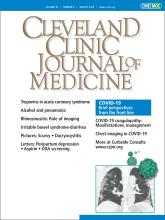To the Editor: I want to commend Drs. Tough DeSapri and Brook for their excellent summary on the use of the FRAX tool in assessing the need for dual-energy x-ray absorptiometry (DXA) in postmenopausal women.1
A thought experiment that we engage in with our fellows is to take the FRAX tool and calculate the changes in 10-year fracture risk obtained by changing each of the parameters. For example, the patient discussed in the article would have a 10-year risk of a hip fracture of 0.4%. However, if we add 16 years to her age (making her 72 years old), her level of risk is 3.0%, which would justify the use of a medical intervention such as a bisphosphonate. Similarly, her risk increases to 1.3% if she had suffered a previous fracture, and to 0.8% if she had taken a significant amount of glucocorticoids.
Many of us compensate for the lack of quantitation in the FRAX questionnaire by using “fudge factors.” For glucocorticoids, we increase the fracture risk by 15% if a patient was on more than 7.5 mg of prednisone for 3 or more months.2
One glaring deficiency in the FRAX score is an absence of any reference to diabetes. Type 2 diabetes mellitus is associated with a significant risk of fracture without a significant decrease in bone density.3 Suggested compensations include adding 10 years to the patient’s age or checking “yes” for rheumatoid arthritis when calculating FRAX for a patient with type 2 diabetes mellitus.
The trabecular bone score mentioned by DeSapri and Brook is a way of getting at the issue of bone quality and at least partially corrects the calculation of fracture risk for the diabetic patient. Data entry for the trabecular bone score is now built into the online FRAX tool and can be added after clicking “Calculate.” Race also is now available for the US FRAX tool.
- Copyright © 2020 The Cleveland Clinic Foundation. All Rights Reserved.






